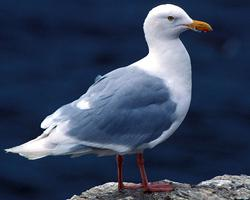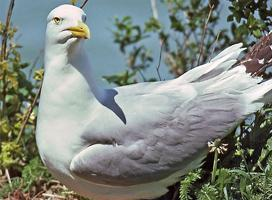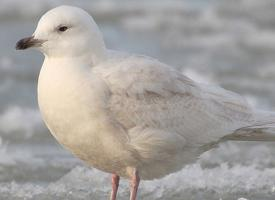
Veszélyeztetettség
| Veszélyeztetett |
Állatleírás
The Glaucous Gull (Larus hyperboreus) is a large species of seabird that belongs to the gull family, Laridae. It is notable for its impressive size and distinctive pale plumage, which sets it apart from other gulls. This bird is a circumpolar species primarily found in the Arctic regions, including parts of North America, Europe, and Asia. It is a migratory bird, with some populations traveling south to cooler, temperate zones during the harsh Arctic winter.Adult Glaucous Gulls have a striking appearance. They possess a very pale, almost white plumage that covers their bodies, with light grey back and upper wings. The tips of their wings are white, lacking the black markings that are typical of many other gull species. Their large, powerful bills are pink with a distinctive red spot on the lower mandible, a feature that plays a crucial role in their feeding behavior. Their eyes are pale, surrounded by a thin ring of bare, pinkish skin, and their legs are a flesh-colored pink, blending seamlessly with their overall pale appearance.
These gulls are among the largest in the world, with a wingspan that can reach up to 150-170 cm (59-67 inches). Their size gives them a dominant presence among other seabirds, and they are known to be aggressive predators and opportunistic feeders. Their diet is varied and includes fish, small birds, eggs, carrion, and even refuse. This adaptability in feeding habits allows them to thrive in the harsh Arctic environment, as well as in human-altered landscapes where they can scavenge for food.
Glaucous Gulls breed in the Arctic, choosing nesting sites on cliffs, rocky outcrops, or on the ground in more open areas. They are colonial nesters, with some colonies consisting of a few pairs to several hundred. Their nests are constructed from vegetation, feathers, and debris, forming a substantial structure in which the female lays 2 to 4 eggs. Both parents share in the incubation duties, which last about a month, and in caring for the chicks once they hatch.
Juvenile Glaucous Gulls go through a series of plumage changes over their first four years of life, transitioning from a mottled brown and gray appearance to the pale adult plumage. These changes can make identification challenging, especially when considering the bird's similarity to other large gulls, such as the Iceland Gull (Larus glaucoides).
As migratory birds, Glaucous Gulls play a vital role in the ecosystems they inhabit. They are both predators and scavengers, contributing to the control of animal populations and the cleanup of carrion. However, their presence in human environments can sometimes lead to conflicts, especially in areas where they compete with humans for fish or scavenge in urban areas.
Despite the challenges they face, Glaucous Gulls are currently considered to be of Least Concern by the International Union for Conservation of Nature (IUCN), indicating that their populations are stable. However, like many Arctic species, they are potentially vulnerable to the impacts of climate change, pollution, and habitat disturbance. Conservation efforts aimed at preserving their natural habitats and monitoring their population trends are essential to ensure the continued survival of this remarkable species in the face of a changing world.
Hasonló állatok
Új állatfotók
Top 10 állat
- Dolphin gull (Leucophaeus scoresbii)
- Diana monkey (Cercopithecus diana)
- Moustached guenon (Cercopithecus cephus)
- Galápagos tortoise (Geochelone nigra complex)
- Russian tortoise (Testudo horsfieldii)
- Stone loach (Barbatula barbatula)
- Japanese macaque (Macaca fuscata)
- Greek tortoise (Testudo graeca)
- Common flying dragon (Draco volans)
- Vendace (Coregonus albula)


